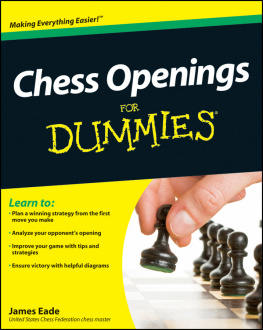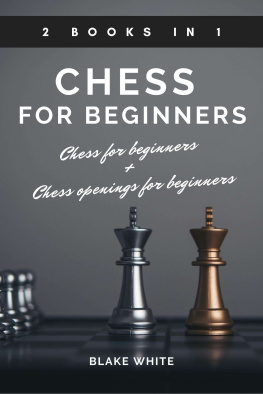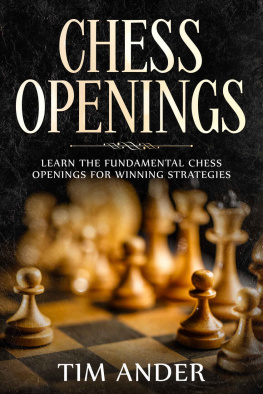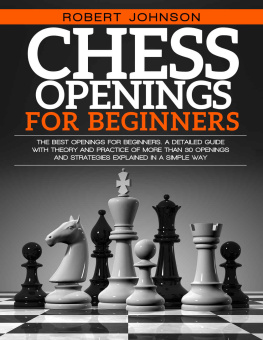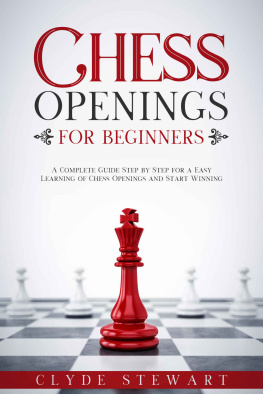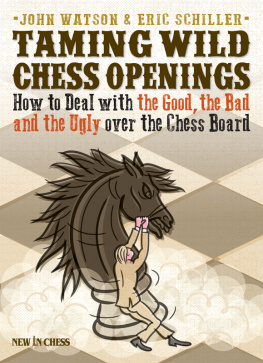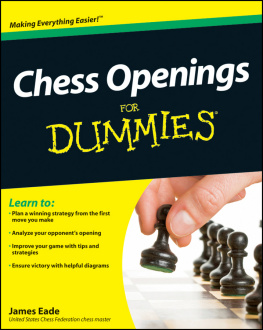Lev Alburt - Chess Openings for Black, Explained
Here you can read online Lev Alburt - Chess Openings for Black, Explained full text of the book (entire story) in english for free. Download pdf and epub, get meaning, cover and reviews about this ebook. publisher: Chess Information & Research Institute, genre: Home and family. Description of the work, (preface) as well as reviews are available. Best literature library LitArk.com created for fans of good reading and offers a wide selection of genres:
Romance novel
Science fiction
Adventure
Detective
Science
History
Home and family
Prose
Art
Politics
Computer
Non-fiction
Religion
Business
Children
Humor
Choose a favorite category and find really read worthwhile books. Enjoy immersion in the world of imagination, feel the emotions of the characters or learn something new for yourself, make an fascinating discovery.
- Book:Chess Openings for Black, Explained
- Author:
- Publisher:Chess Information & Research Institute
- Genre:
- Rating:4 / 5
- Favourites:Add to favourites
- Your mark:
- 80
- 1
- 2
- 3
- 4
- 5
Chess Openings for Black, Explained: summary, description and annotation
We offer to read an annotation, description, summary or preface (depends on what the author of the book "Chess Openings for Black, Explained" wrote himself). If you haven't found the necessary information about the book — write in the comments, we will try to find it.
Chess Openings for Black, Explained — read online for free the complete book (whole text) full work
Below is the text of the book, divided by pages. System saving the place of the last page read, allows you to conveniently read the book "Chess Openings for Black, Explained" online for free, without having to search again every time where you left off. Put a bookmark, and you can go to the page where you finished reading at any time.
Font size:
Interval:
Bookmark:
 Chess Openingsfor Black,ExplainedA Complete Repertoire 2nd Edition, Revised and Updated by Lev Alburt, Roman Dzindzichashvili,
Chess Openingsfor Black,ExplainedA Complete Repertoire 2nd Edition, Revised and Updated by Lev Alburt, Roman Dzindzichashvili,
and Eugene Perelshteyn with AI Lawrence T his book provides you with a complete repertoire for Black, no matter what reasonable first move White makes. Two of your three authors are international grandmasters and repeat winners of the U.S. Championship. The third and youngest of us, Eugene Perel-shteyn, was an IM when we wrote the original work in 2005; now he is a strong grandmaster. This volume contains every secret the authors have compiled over decades of research in the recommended openings, and are still constantly digging for. No theoretical novelty ( TN ) will be withheld from you.
Such information is normally revealed only to world championship contenders, who hire top theoreticians, like Roman Dzin-dzichashvili, for that purpose. But shared TNs are only one of this books unusual offerings.  Eugene Perelshteyn To derive the most benefit, you should first understand what the book is designed to do. of our five-part volume makes this point clear. It helps if you understand who the authors are and what they bring to you thats unique. Im a three-time U.S.
Eugene Perelshteyn To derive the most benefit, you should first understand what the book is designed to do. of our five-part volume makes this point clear. It helps if you understand who the authors are and what they bring to you thats unique. Im a three-time U.S.
Champion turned chess instructor. My books, including the Comprehensive Chess Course: from beginner to master, which I coauthored and published, are among the best received chess instruction in the U.S.  Roman Dzindzichashvill GM Roman Dzindzichashvili (Dzindzi to his many fans) has been one of the prime movers and creators of modern opening theory for the past 40 years. His advice and help has been sought, with rewarding results, by such greats as Boris Spassky, Victor Korchnoi, Anatoly Karpov and Gata Kamsky. In fact, Romans revolutionary reassessment of the main line of the Scandinavian Opening allowed American Gata Kamsky to win a game (with Black) and then the match against world championship contender Vishy Anand. At that time, Gata was losing by two points with two games to go in a match played in Anands home turf, India, for the right to play the world champion.
Roman Dzindzichashvill GM Roman Dzindzichashvili (Dzindzi to his many fans) has been one of the prime movers and creators of modern opening theory for the past 40 years. His advice and help has been sought, with rewarding results, by such greats as Boris Spassky, Victor Korchnoi, Anatoly Karpov and Gata Kamsky. In fact, Romans revolutionary reassessment of the main line of the Scandinavian Opening allowed American Gata Kamsky to win a game (with Black) and then the match against world championship contender Vishy Anand. At that time, Gata was losing by two points with two games to go in a match played in Anands home turf, India, for the right to play the world champion.
Roman is extremely generous in sharing his ideas. Perhaps thats because he knows he can always create new, equally important ones! In the 1984 U.S. Championship, Roman gave me a tool to handle the Anti-Benko move order: 1. d4 Nf6 2. Nf3. e6 3. c4 a6!?. c4 a6!?.
This paradoxical move (later christened the Dzindzi-Indian) remains unrefuted, and can be very useful in the hands of devoted Benko/Benoni players. It took me less than an hour to grasp the ideas behind this amazing systemand 90% of the credit goes to Romans innate ability to single out and emphasize essentials, and to convey his knowledge of moves and ideas in a logical, easy-to-learn, easy-to-remember and practical way. Every chess player should know how good it feels to go into a game completely confident in his opening repertoire, and its even better when you have an important novelty or two up your sleeve. Not surprisingly, I played very well in this tournament. And with 3.... a6 (first looked upon as completely ridiculous), I scored 2 out of 3 versus Jim Tarjan, Larry Christiansen and Yasser Seirawanall top GMs.
Such a result (with Black!) couldnt help but catapult me into clear first placemy first U.S. Championship crown. Importantly, the Dzindzi-Indian wasnt a surprise novelty for one game (or one tournament) only. A year later, in another U.S. Championship, Christiansen tried to smash my position with a homemade, aggressive line. But Dzindzis and my analyses held.
I got an equal position (but one that was very sharp, and very familiar to me), eventually winning. Many opponents soon gave up trying to deal with Dzindzis innovation and switched to other openings! Romans teaching talents arent limited to GM chessas the enormous popularity of his Romans Forums and Labs videos attests. Dzindzis TNs, ideas and, crucially, the convincing way he presents them, should help readers of this book feel as confident as I did during the 1984 U.S. Championship. As a result, youll win many important gameswhether youre playing a friend at home or competing in the U.S. Masters! Youll find in this book many games played by Romans student and our co-author, Eugene Perelshteyn.
He helped Roman with opening research, checked their co-discoveries with computer programs and tested some of them, with success, against top GM opponents. Putting it all together Just the Facts!, the seventh and final book in the Comprehensive Chess Course, is one of the fastest-selling endgame books of all time. It was selected by the Chess Journalists of America as the best book of 2000-2001. Comprehensive Chess Course Executive Editor Al Lawrence built special features into that seriesand now into this book. These features make these books especially easy to learn from. Al is a former teacher with advanced degrees in curriculum and instruction.
Additionally, Al is a former Executive Director of the U.S. Chess Federation and then served as volunteer Executive Director of the World Chess Hall of Fame in Miami. He is president of OutExcel! Corp, a marketing and publishing firm.  Al Lawrence Al is the author of more than a dozen books and scores of articles of his own on a variety of subjects. He writes on chess with great style and unique perspective. In fact, he was voted 20002001 Chess Journalist of the Year.
Al Lawrence Al is the author of more than a dozen books and scores of articles of his own on a variety of subjects. He writes on chess with great style and unique perspective. In fact, he was voted 20002001 Chess Journalist of the Year.
The new series: Alburts Chess Openings After Nikolay Krogius and I completed the endgame book Just the Facts!, only one part of the game, the opening, remained to be explained. (It wasnt within the scope of the Course to tackle opening theory in detail.) Many of you are already familiar with Pirc Alert!: A Complete Defense against 1. e4, which I co-authored with the Pircs number one practitioner, GM Alex Chernin. In Chess Openings for Black, Explained and its White companion volume, Roman, Eugene and I provide you with a solid, effective and interconnected repertoire for both White and Blackplus reviews of all other openings from both sides points of view. Following in the tradition of Pirc Alert!, our goal was: To convey the overall understanding of openings in such a way that it makes its readers self-reliant; To reveal all the theoretical secrets, often five to 10 years before they get into the opening reference books; To do all this with respect for the other demands on the readers time. How we selected these openings The criteria we used to select an opening for the repertoire are: Its completely sound, even up to the super-GM level; It rewards ideas rather than rote memorizationthus its theory can be reduced to a relatively small and completely understandable portion; We gave preference to openings rich in our TNs! Who should read this book? Players of all strengths, from beginners to super-GMs, will profit from this book.
Here are some who will benefit most: Anyone who already plays some of the recommended openingsfor you this book will be like having the personal opening notebook you always wanted; Anyone who has to play against these lines; Anyone who wants to develop a comprehensive, coherent and completely modern, competitive repertoire for Black, without gaps in his understanding; 
Font size:
Interval:
Bookmark:
Similar books «Chess Openings for Black, Explained»
Look at similar books to Chess Openings for Black, Explained. We have selected literature similar in name and meaning in the hope of providing readers with more options to find new, interesting, not yet read works.
Discussion, reviews of the book Chess Openings for Black, Explained and just readers' own opinions. Leave your comments, write what you think about the work, its meaning or the main characters. Specify what exactly you liked and what you didn't like, and why you think so.


